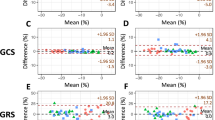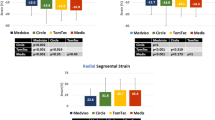Abstract
Objectives
To compare the reproducibility of cardiovascular magnetic resonance feature-tracking (CMR-FT) packages to assess global left ventricular (LV) myocardial strain.
Methods
In 45 subjects (i.e. 15 controls, 15 acute myocardial infarction, 15 dilated cardiomyopathy patients), we determined inter-vendor, inter-observer (two readers) and intra-observer reproducibility of peak systolic global radial, circumferential and longitudinal strain (GRS, GCS and GLS, respectively) comparing four commercially available software packages. Differences between vendors were assessed with analysis of variance (ANOVA), between observers and readings with intraclass correlation coefficient (ICC) and coefficient of variation (CV).
Results
The normalised end-diastolic volume was 91, 77 and 119 ml/m2 (median, Q1, Q3) and ejection fraction was 41 ± 14%, range 12-67%. Global longitudinal strain (GLS), global circumferential strain (GCS) and global radial strain (GRS) values were 13.9% ± 5.4% (3.9-23.8%), 12.2% ± 5.8% (1.0-25.1%) and 32.0% ± 14.7 (3.6-67.8%), respectively. ANOVA showed significant differences between vendors for GRS (p < 0.001) and GLS (p = 0.018), not for GCS (p = 0.379). No significant bias was found for both intra- and inter-observer variability. The ICC for inter- and intra-observer reproducibility ranged 0.828-0.991 and 0.902-0.997, respectively. The CV, however, ranged considerably, i.e. 4.0-28.8% and 2.8- 27.7% for inter- and intra-observer reproducibility, respectively. In particular, for GRS differences in CV values between vendors were large, i.e. 5.2-28.8% and 2.8-27.7%, for inter- and intra-observer reproducibility, respectively.
Conclusions
In a cohort of subjects with a wide range of cardiac performances, GRS and GLS values are not interchangeable between vendors. Moreover, although intra- and inter-observer reproducibility amongst vendors is excellent, some vendors encounter problems to reproducibly measure global radial strain.
Key Points
• Different software packages are currently available for myocardial strain assessment using routinely acquired cine CMR images.
• Global myocardial strain values are not interchangeable between vendors for global longitudinal and global radial strain.
• Inter- and intra-observer reproducibility for global strain assessment is excellent. However, some vendors encounter problems to reproducibly measure global radial strain.






Similar content being viewed by others
Abbreviations
- CMR:
-
Cardiovascular magnetic resonance
- CV:
-
Coefficient of variation
- DCM:
-
Dilated cardiomyopathy
- EF:
-
Ejection fraction
- FT:
-
Feature-tracking
- GCS:
-
Global circumferential strain
- GLS:
-
Global longitudinal strain
- GRS:
-
Global radial strain
- LV:
-
Left ventricle
References
Smiseth OA, Torp H, Opdahl A, Haugaa KH, Urheim S (2016) Myocardial strain imaging: how useful is it in clinical decision making? Eur Heart J 37:1196–1207
Kalam K, Otahal P, Marwick TH (2014) Prognostic implications of global LV dysfunction: a systematic review and meta-analysis of global longitudinal strain and ejection fraction. Heart 100:1673–1680
Thavendiranathan P, Poulin F, Lim KD, Plana JC, Woo A, Marwick TH (2014) Use of myocardial strain imaging by echocardiography for the early detection of cardiotoxicity in patients during and after cancer chemotherapy: a systematic review. J Am Coll Cardiol 63:2751–2768
Luetkens JA, Schlesinger-Irsch U, Kuetting DL et al (2017) Feature-tracking myocardial strain analysis in acute myocarditis: diagnostic value and association with myocardial oedema. Eur Radiol 27:4661–4671
Maret E, Todt T, Brudin L et al (2009) Functional measurements based on feature tracking of cine magnetic resonance images identify left ventricular segments with myocardial scar. Cardiovasc Ultrasound 7:53
Hor KN, Baumann R, Pedrizzetti G et al (2011) Magnetic resonance derived myocardial strain assessment using feature tracking. J Vis Exp 48:e2356
Schuster A, Hor KN, Kowallick JT, Beerbaum P, Kutty S (2016) Cardiovascular magnetic resonance myocardial feature tracking. Concepts and clinical applications. Circ Cardiovasc Imaging 9:e0004077
Zweerink A, Allaart CP, Kuijer JPA et al (2017) Strain analysis in CRT candidates using the novel segment length in cine (SLICE) post-processing technique on standard CMR cine images. Eur Radiol 27:5158–5168
Schuster A, Stahnke V-C, Unterberg-Buchwald C et al (2015) Cardiovascular magnetic resonance feature-tracking assessment of myocardial mechanics: intervendor agreement and considerations regarding reproducibility. Clin Radiol 70:989–998
Morton G, Schuster A, Jogiya R, Kutty S, Beerbaum P, Nagel E (2012) Inter-study reproducibility of cardiovascular magnetic resonance myocardial feature tracking. J Cardiovasc Magn Reson 14:43
Singh A, Steadman CD, Khan JN et al (2015) Intertechnique agreement and interstudy reproducibility of strain and diastolic strain rate at 1.5 and 3 Tesla: a comparison of feature-tracking and tagging in patients with aortic stenosis. J Magn Reson Imaging 41:1129–1137
Kuetting DL, Dabir D, Homsi R et al (2016) The effects of extracellular contrast agent (Gadobutrol) on the precision and reproducibility of cardiovascular magnetic resonance feature tracking. J Cardiovasc Magn Reson 18:30
Kowallick JT, Morton G, Lamata P et al (2016) Inter-study variability of left ventricular torsion and torsion rate quantification using MR myocardial feature tracking. J Magn Reson Imaging 43:128–137
Aurich M, Keller M, Greiner S et al (2016) Left ventricular mechanics assessed by two-dimensional echocardiography and cardiac magnetic resonance imaging: comparison of high-resolution speckle tracking and feature tracking. Eur Heart J Cardiovasc Imaging 17:1370–1378
Taylor RJ, Moody WE, Umar F et al (2015) Myocardial strain measurement with feature-tracking cardiovascular magnetic resonance: normal values. Eur Heart J Cardiovasc Imaging 16:871–881
Bourfiss M, Vigneault DM, Aliyari Ghasebeh MA et al (2017) Feature tracking CMR reveals abnormal strain in preclinical arrhythmogenic right ventricular dysplasia/cardiomyopathy: a multisoftware feasibility and clinical implementation study. J Cardiovasc Magn Reson 19:66
Heyde B, Bouchez S, Thieren S et al (2013) Elastic image registration to quantify 3-D regional myocardial deformation from volumetric ultrasound: experimental validation in an animal model. Ultrasound Med Biol 39:1688–1697
Morais P, Heyde B, Barbosa D, Queirós S, Claus P, D’hooge J (2013) Cardiac motion and deformation estimation from tagged MRI sequences using a temporal coherent image registration framework. International Conference on Functional Imaging and Modeling of the Heart. Springer, Berlin Heidelberg
Morais P, Marchi A, Bogaert JA et al (2017) Cardiovascular magnetic resonance myocardial feature tracking using a non-rigid, elastic image registration algorithm. Assessment of variability in a real-life clinical setting. J Cardiovasc Magn Reson 19:24
Cerqueira MD, Weissman NJ, Dilsizian V et al (2002) American Heart Association Writing Group on Myocardial Segmentation and Registration for Cardiac Imaging. Standardized myocardial segmentation and nomenclature for tomographic imaging of the heart. A statement for healthcare professionals from the Cardiac Imaging Committee of the Council on Clinical Cardiology of the American Heart Association. Circulation 105:539–542
Fleiss JL, Levin B, Paik MC (2003) Statistical methods for rates and proportions, 3rd edn. Wiley, Hoboken
Schmidt B, Dick A, Treutlein M et al (2017) Intra- and inter-observer reproducibility of global and regional magnetic resonance feature tracking derived strain parameters of the left and right ventricle. Eur J Radiol 89:97–105
Masci PG, Dymarkowski S, Rademakers FE, Bogaert J (2009) Determination of regional ejection fraction in patients with myocardial infarction by using merged late gadolinium enhancement and cine MR: feasibility study. Radiology 250:50–60
Nordlund D, Heiberg E, Carlsson M et al (2016) Extent of myocardium at risk for left anterior descending artery, right coronary artery, and left circumflex artery occlusion depicted by contrast-enhanced steady-state free precession and T2-weighted short-tau inversion recovery magnetic resonance imaging. Circ Cardiovasc Imaging 9(7)
Mirea O, Pagourelias ED, Duchenne J et al (2018) Intervendor differences in the accuracy of detecting regional functional abnormalities: a report from the EACVI-ASE Strain Standardization Task Force. JACC Cardiovasc Imaging 11:25–34
Mirea O, Pagourelias ED, Duchenne J et al (2018) Variability and reproducibility of segmental longitudinal strain: a report from the EACVI-ASE Strain Standardization Task Force. JACC Cardiovasc Imaging 11(1):15–24
Farsalinos KE, Daraban AM, Ûnlü S, Thomas JD, Badano LP, Voigt JU (2015) Head-to-head comparison of global longitudinal strain measurements among nine different vendors. The EACVI/ASE Inter-vendor comparison study. J Am Soc Echocardiogr 28:1171–1181
Funding
The authors state that this work has not received any funding.
Author information
Authors and Affiliations
Corresponding author
Ethics declarations
Guarantor
The scientific guarantor of this publication is Jan Bogaert
Conflict of interest
The authors of this manuscript declare no relationships with any companies, whose products or services may be related to the subject matter of the article.
Statistics and biometry
One of the authors has significant statistical expertise.
Informed consent
Written informed consent was waived by the Institutional Review Board.
Ethical approval
Institutional Review Board approval was obtained.
Methodology
• retrospective
• cross sectional study
• performed at one institution
Rights and permissions
About this article
Cite this article
Barreiro-Pérez, M., Curione, D., Symons, R. et al. Left ventricular global myocardial strain assessment comparing the reproducibility of four commercially available CMR-feature tracking algorithms. Eur Radiol 28, 5137–5147 (2018). https://doi.org/10.1007/s00330-018-5538-4
Received:
Revised:
Accepted:
Published:
Issue Date:
DOI: https://doi.org/10.1007/s00330-018-5538-4




